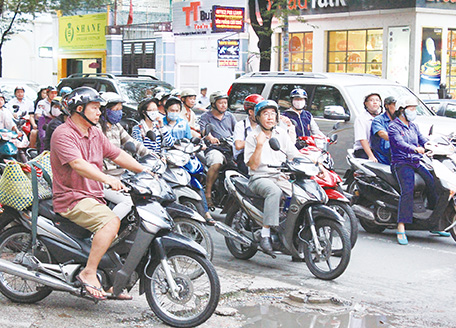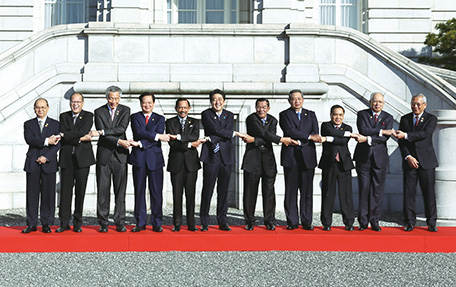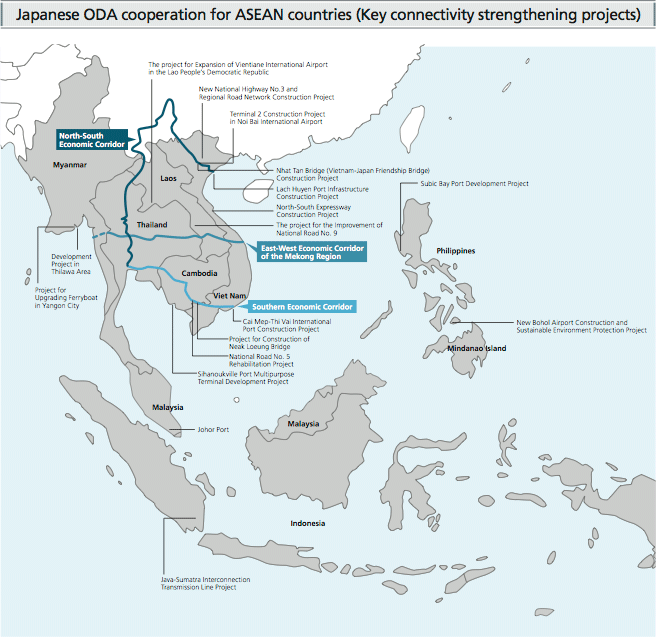Japan's Official Development Assistance White Paper 2013
Chapter 2 The Growth of Southeast Asia and the Role of Japan

Motorbikes driving in Ho Chi Minh City, Viet Nam (Photo: NNA=Kyodo)
Section 1 Realizing Growth through Infrastructure Development
The year 2013 marks the 40th year since the start of exchanges between Japan and ASEAN. Various commemorative events were held in Japan and ASEAN member states throughout 2013. In December, the ASEAN-Japan Commemorative Summit was convened in Japan. Over the past 40 years, Japan and ASEAN have forged close cooperative relations for the peace, stability, development, and prosperity in this region. In particular, the mid-1980s and onwards saw a proliferation of Japanese companies entering ASEAN markets, against the backdrop of the yen’s rapid appreciation. For many Japanese companies, ASEAN member states have become key investment destinations as well as important business partners.
Through ODA, Japan has supported ASEAN countries with infrastructure development, human resource development, and improvement of the trade and investment environment. Adopting the view that economic growth is key to poverty reduction, Japan’s ODA has been directed at sectors which directly help the poor, including the education, health, and medical fields, as well as at stimulating trade and investment through economic infrastructure development, improving the investment environment, including legal system development, human resource development, private sector development, and promoting technology transfers. The region which embodies such ODA support and in which such support blossomed into growth is Southeast Asia. For instance, for the development of the East-West and North-South Economic Corridors indispensable to the economic development of the Mekong region, Japan implemented arterial road development and rehabilitation projects. Specific examples include: road construction and improvement (National Road No. 1 [Cambodia] and the Project for Improvement of National Road No.9 as East-West Economic Corridor of the Mekong Region [Laos]); bridge construction (Kizuna Bridge [Cambodia] and Second Mekong Bridge [Cambodia]); and airport and port improvement (Sihanoukville Port [Cambodia] and Da Nang Port [Viet Nam]). In island countries, such as Indonesia, Malaysia, and the Philippines, Japan contributed to the improvement of numerous ports to develop the Maritime ASEAN Economic Corridor, including Subic Bay Port (the Philippines) and Johor Port (Malaysia). Furthermore, Japan has an extensive track record in such support as technical cooperation for capacity development in infrastructure maintenance and management and in customs and the dispatch of advisors for improving the investment environment.
Thus, the development of the business environment through ODA further encouraged private investment and gave impetus to Japanese companies’ advance into ASEAN member states. Today, the ASEAN region has a population of approximately 600 million people and has grown to become a massive market with a GDP totaling over $2 trillion. Drawing attention as a key “production base,” Japanese investment in the ASEAN region accounts for approximately 17% of Japan’s foreign direct investment in 2011. Japan’s ODA has functioned effectively as “investment in the future” for both ASEAN member states and Japan, and supported the development and prosperity of Japan and ASEAN member states.
By 2015, ASEAN aims to establish the “ASEAN Community,” which is comprised of three pillars, namely the “Political-Security Community,” “Economic Community,” and “Socio-Cultural Community.” To achieve this, “strengthening connectivity” is deemed to be at the top of their agenda. During the 17th ASEAN Summit in October 2010, the master plan for strengthening connectivity was adopted, which has three components, namely: “physical connectivity” including transport, information communications, and energy network; “institutional connectivity” including the liberalization and facilitation of trade, investment, and services; and “people-to-people connectivity” in tourism, education, and culture.
With Japan’s past contributions for ASEAN countries in the areas of infrastructure development and investment environment development serving as a cornerstone, based on the understanding that “a more closely integrated ASEAN functioning as a hub of regional cooperation is important for the stability and prosperity of Japan, ASEAN and all of East Asia,” Japan offers its full support for ASEAN’s efforts, including by unveiling flagship projects for strengthening ASEAN connectivity, such as the “National Road No. 5 Rehabilitation Project” and the “Project for Construction of Neak Loeung Bridge” in Cambodia, which comprises the South Economic Corridor, and the “ASEAN Ro-Ro Shipping Network Development Project.”
In 2013, on the 40th Year of ASEAN-Japan Friendship and Cooperation, Japan and the ten ASEAN member states held an array of exchange programs and conferences throughout the year covering a wide range of areas, including politics, economy, culture, youth exchange, and tourism. In December, the ASEAN-Japan Commemorative Summit was held in Tokyo, at which a mid- to long-term vision was presented for strengthening the Japan-ASEAN relations. Prime Minister Shinzo Abe pledged that Japan would continue its infrastructure assistance and assistance to narrow the development gap in the region in order to continue to strengthen ASEAN connectivity, and announced Japan’s ODA commitment on the scale of ¥2 trillion over the next five years. This commitment is expected to give further momentum to Japan-ASEAN cooperation for strengthening ASEAN connectivity.
ODA is expected to play an important role also in the context of Japan-ASEAN cooperation for strengthening ASEAN connectivity. Further efforts and creativity are demanded to realize ODA which contributes to forming the bases of the overseas businesses of Japanese companies, while supporting ASEAN’s efforts for integration.

Prime Minister Shinzo Abe and the leaders who attended the ASEAN-Japan Commemorative Summit held in Tokyo in December 2013


“Kizuna Bridge” in Cambodia (Photo: Kenshiro Imamura / JICA)
